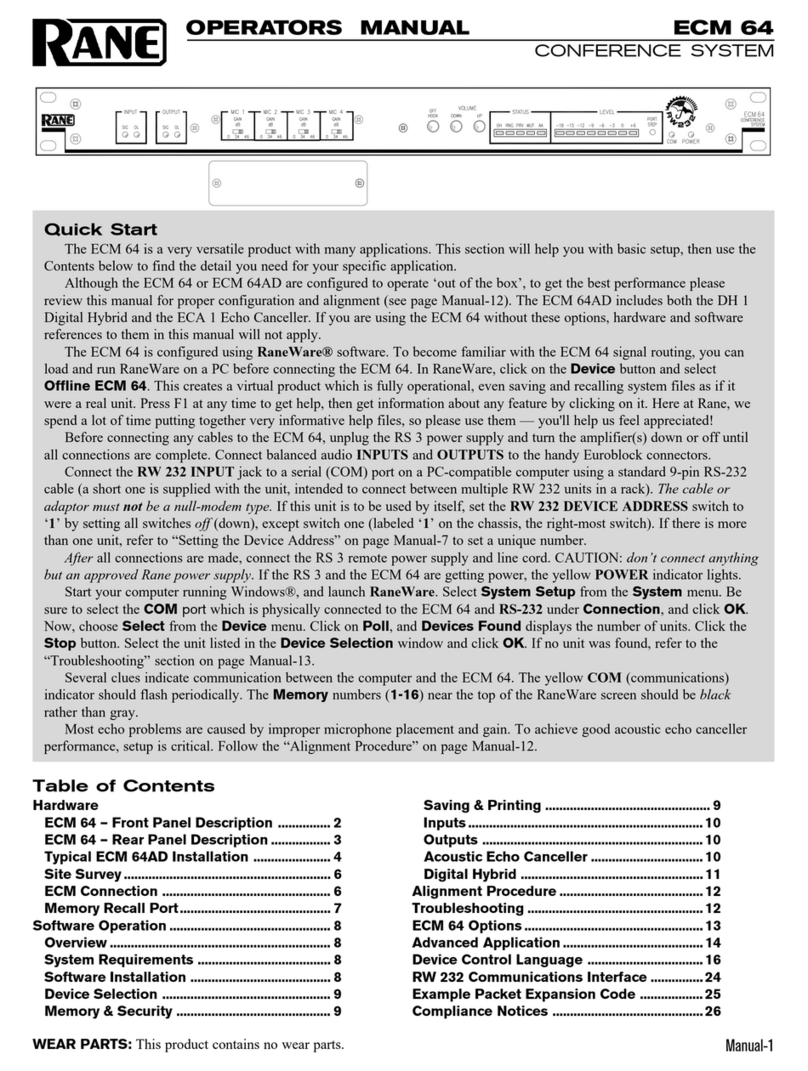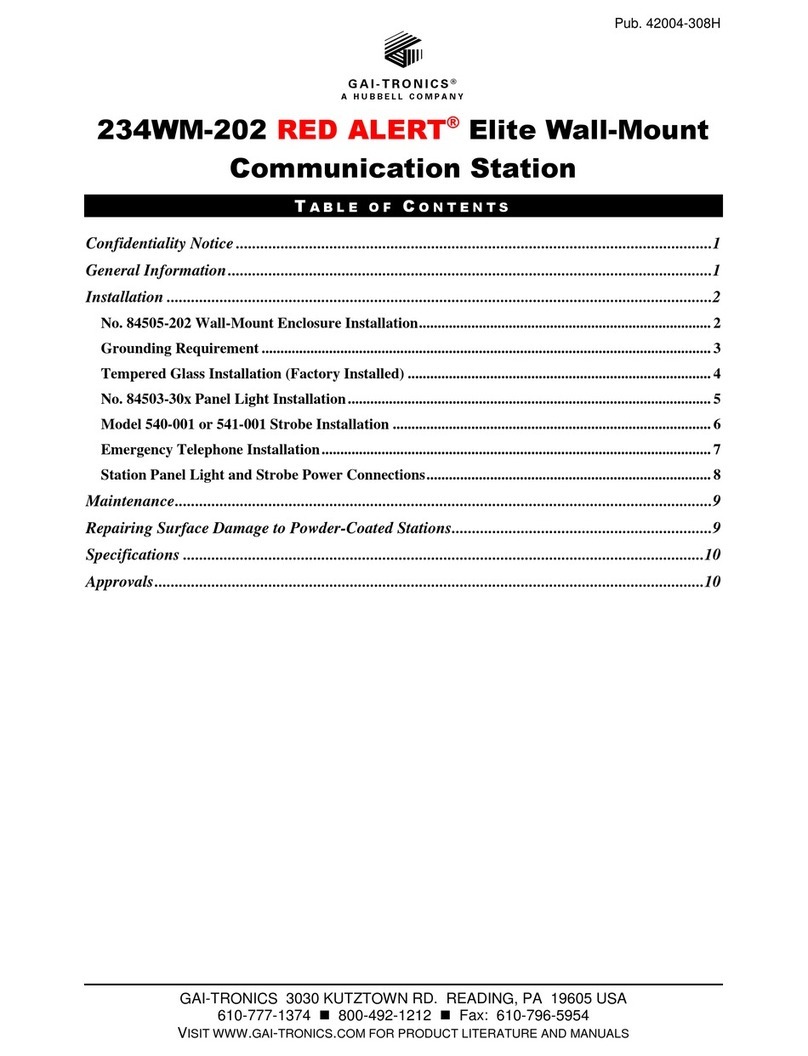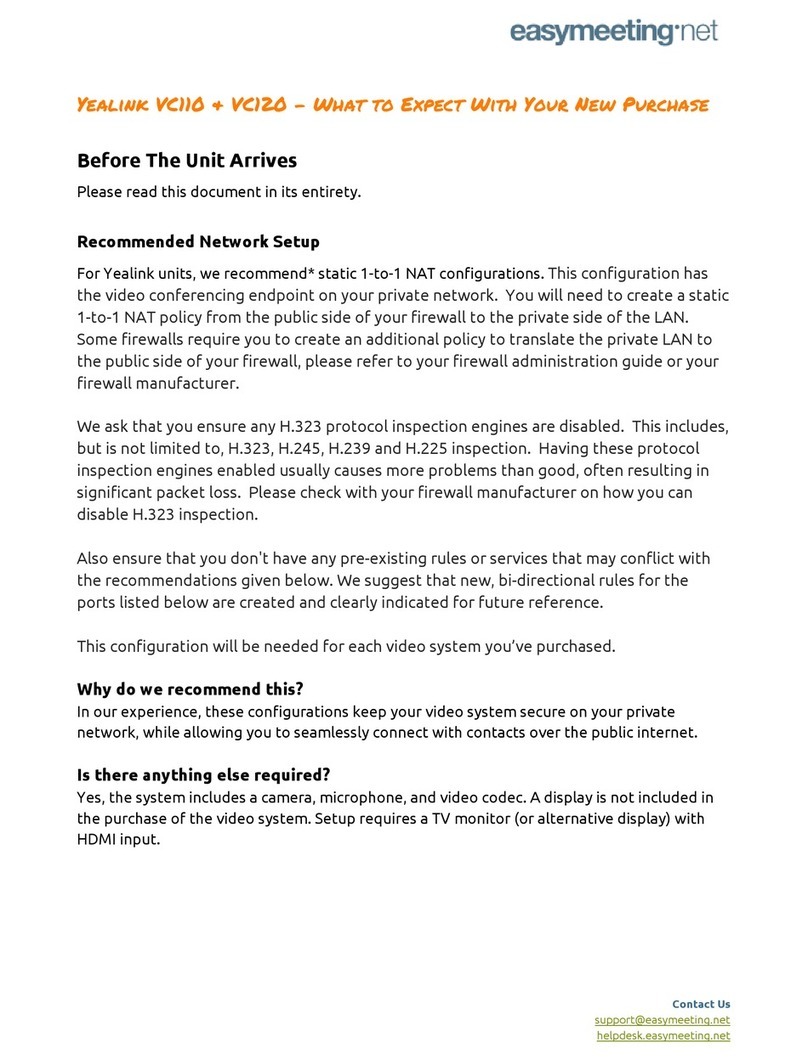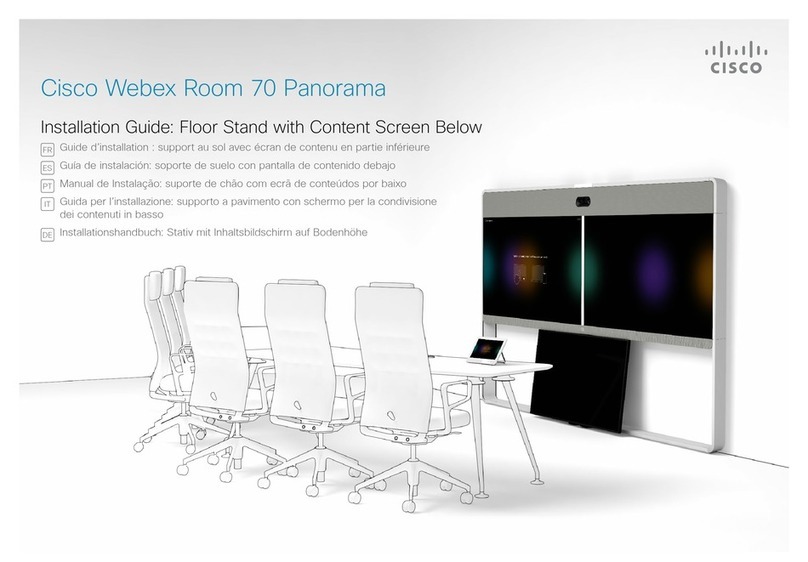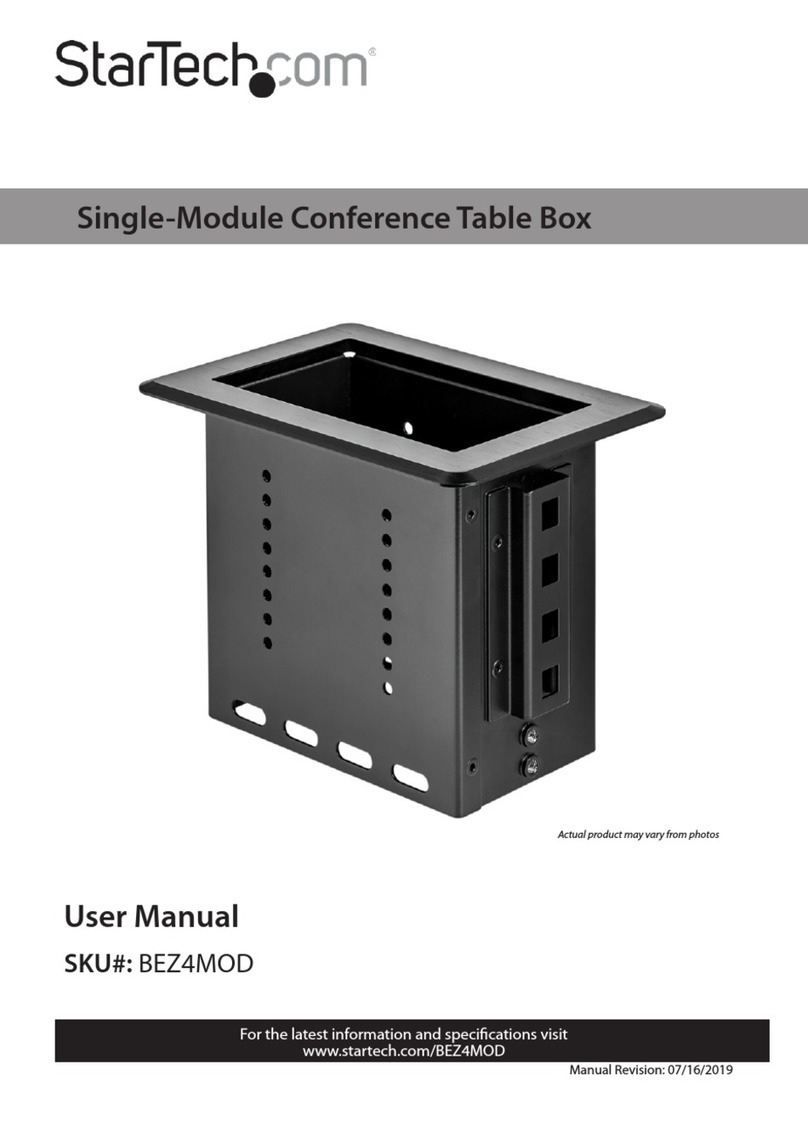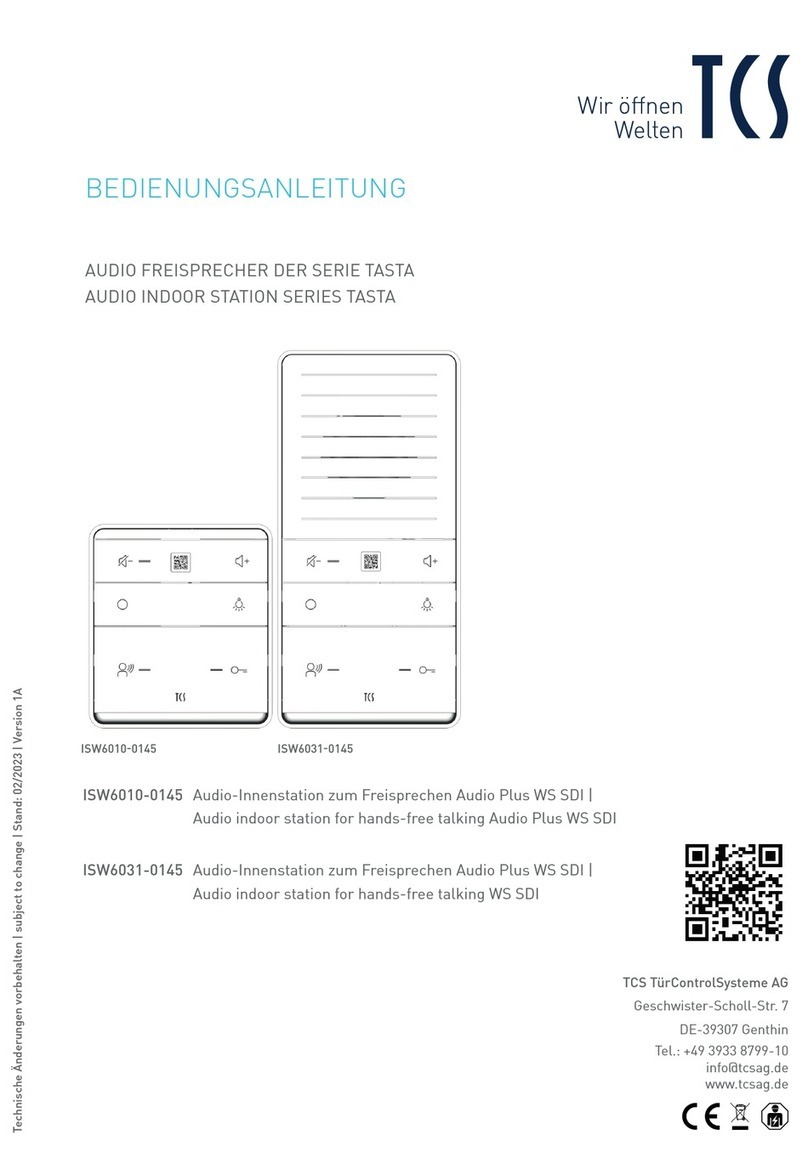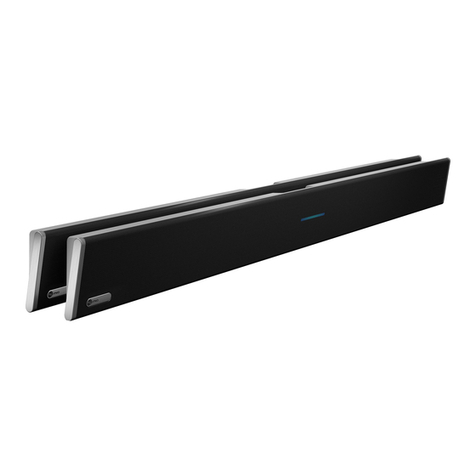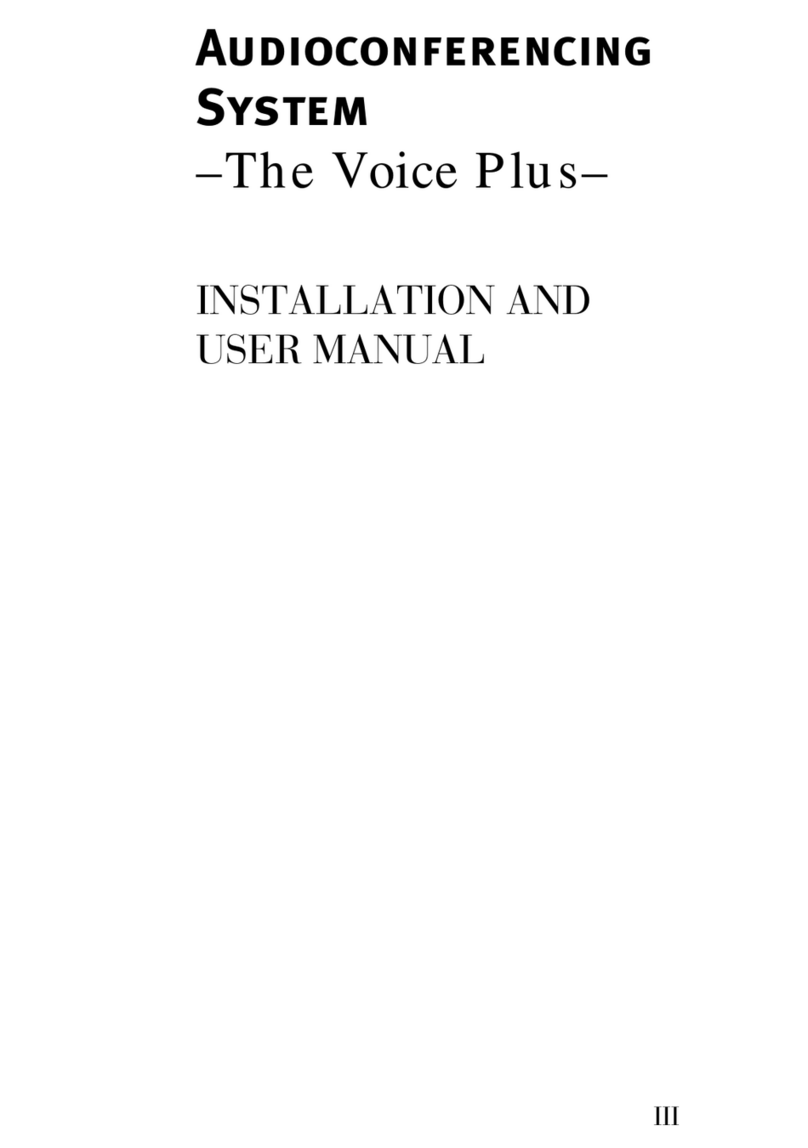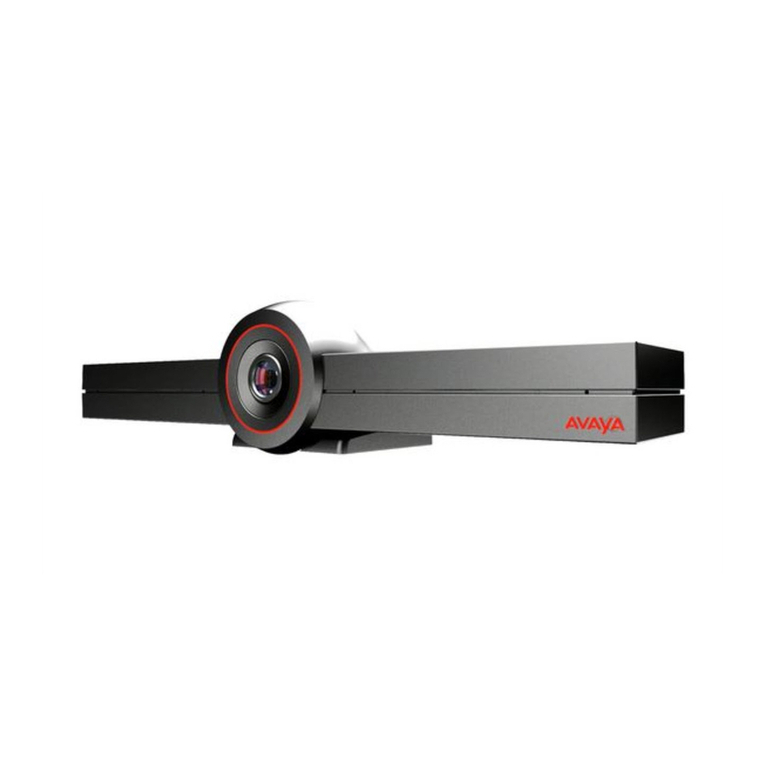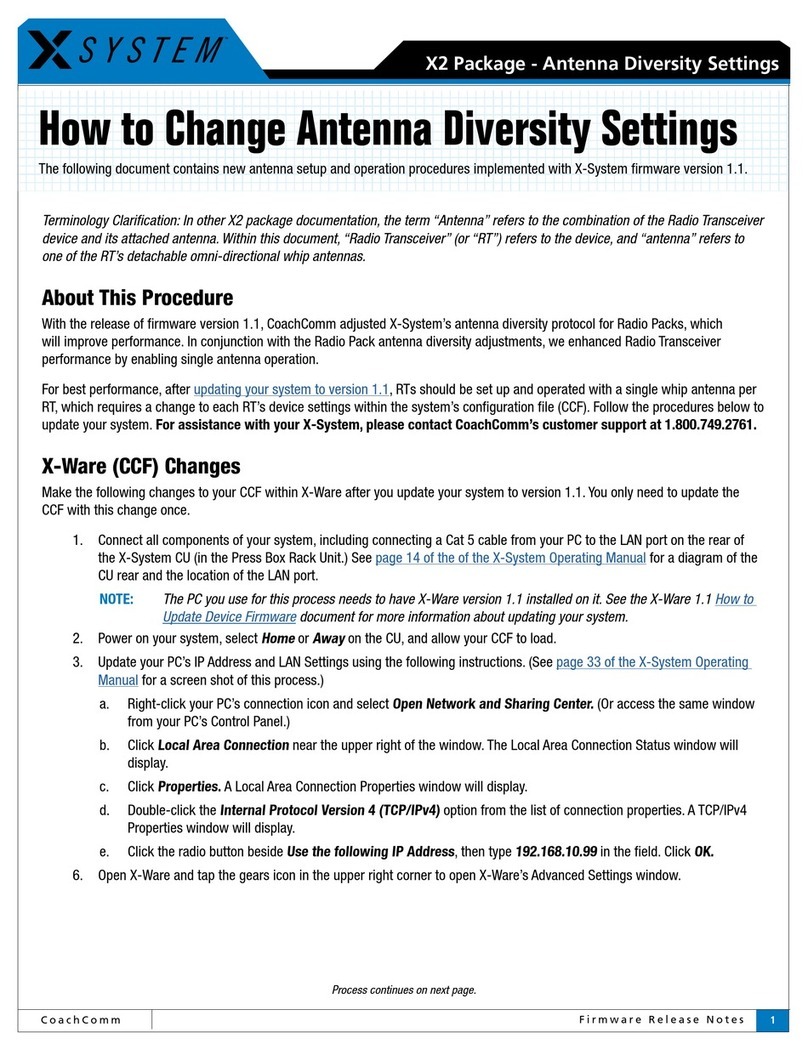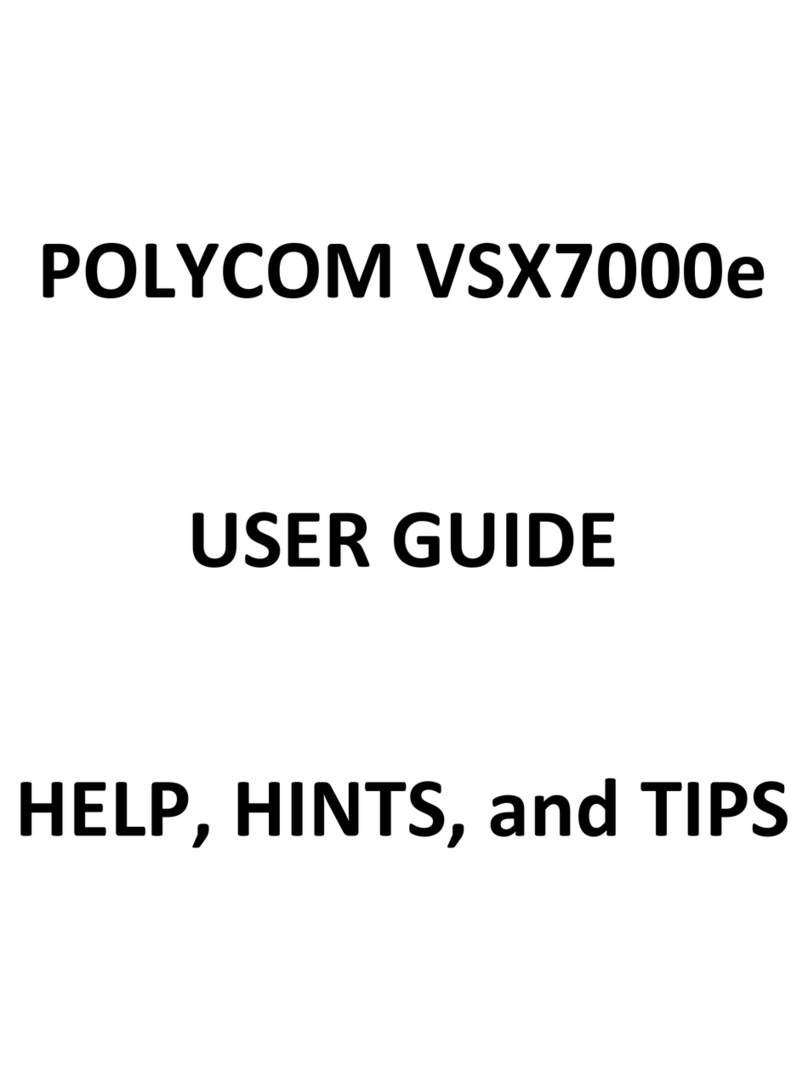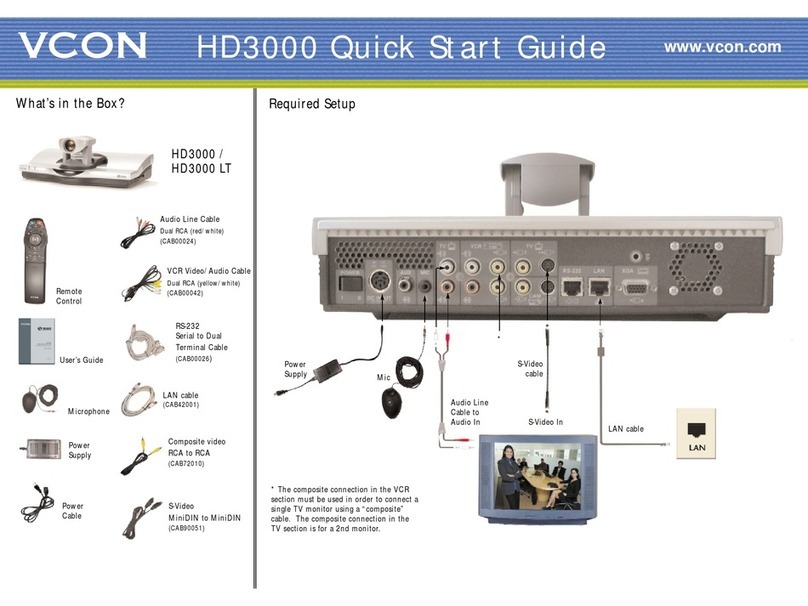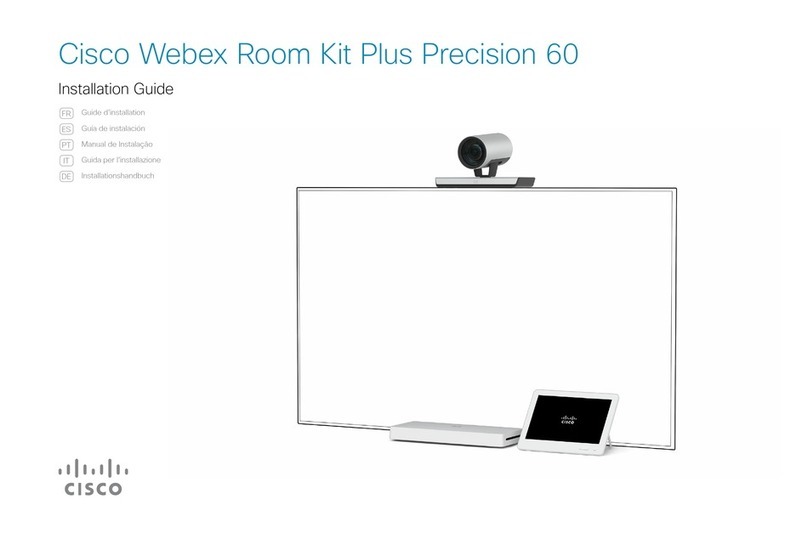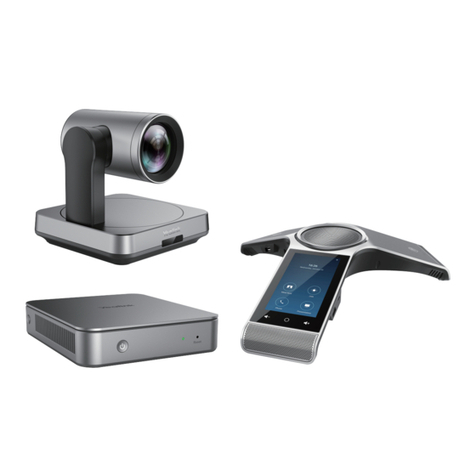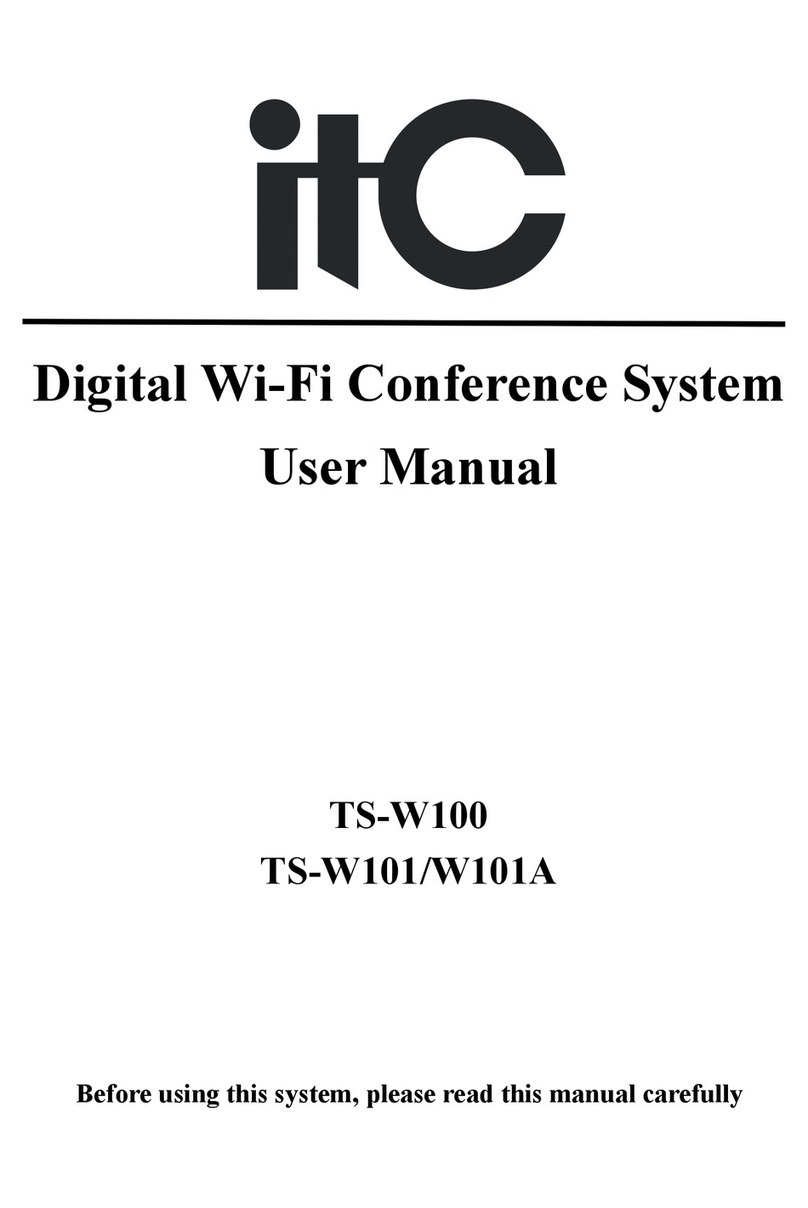TRIGA ECS Series User manual

A
P/N LS10262-002TR-E:A • ECN 151608
Document LS10262-002TR-E
5/4/2021 Rev:
Emergency Communication System
ECS Series
Installation/Operation Manual

2Triga ECS Series Manual — LS10262-002TR-E:A 5/4/2021
Fire Alarm & Emergency Communication System Limitations
While a life safety system may lower insurance rates, it is not a substitute for life and property insurance!
An automatic fire alarm system—typically made up of smoke
detectors, heat detectors, manual pull stations, audible warning
devices, and a fire alarm control panel (FACP) with remote
notification capability—can provide early warning of a developing fire.
Such a system, however, does not assure protection against property
damage or loss of life resulting from a fire.
An emergency communication system—typically made up of an
automatic fire alarm system (as described above) and a life safety
communication system that may include an autonomous control unit
(ACU), local operating console (LOC), voice communication, and
other various interoperable communication methods—can broadcast
a mass notification message. Such a system, however, does not
assure protection against property damage or loss of life resulting
from a fire or life safety event.
The Manufacturer recommends that smoke and/or heat detectors be
located throughout a protected premises following the
recommendations of the current edition of the National Fire Protection
Association Standard 72 (NFPA 72), manufacturer's
recommendations, State and local codes, and the recommendations
contained in the Guide for Proper Use of System Smoke Detectors,
which is made available at no charge to all installing dealers. This
document can be found at http://www.systemsensor.com/appguides/.
A study by the Federal Emergency ManagementAgency (an agency
of the United States government) indicated thatsmoke detectors may
not go off in as many as 35% of all fires. While fire alarm systems are
designed to provide early warning against fire, they do not guarantee
warning or protection against fire. A fire alarm system may not
provide timely or adequate warning, or simply may not function, for a
variety of reasons:
Smoke detectors may not sense fire where smoke cannot reach the
detectors such as in chimneys, in or behind walls, on roofs, or on the
other side of closed doors.Smoke detectors alsomay not sense a fire
on another level or floor of a building. A second-floor detector, for
example, may not sense a first-floor or basement fire.
Particles of combustion or “smoke” from a developing fire may not
reach the sensing chambers of smoke detectors because:
• Barriers such as closed or partially closed doors, walls, chimneys,
even wet or humid areas may inhibit particle or smoke flow.
• Smoke particles may become “cold,” stratify, and not reach the
ceiling or upper walls where detectors are located.
• Smoke particles may be blown away from detectors by air outlets,
such as air conditioning vents.
• Smoke particles may be drawn into air returns before reaching the
detector.
The amount of “smoke” present may be insufficient to alarm smoke
detectors. Smoke detectors are designed to alarm at various levels of
smoke density. If such density levels are not created by a developing
fire at the location of detectors, the detectors will not go into alarm.
Smoke detectors, even when working properly, have sensing
limitations. Detectors that have photoelectronic sensing chambers
tend to detect smoldering fires better than flaming fires, which have
little visible smoke. Detectors that have ionizing-type sensing
chambers tend to detect fast-flaming fires better than smoldering
fires. Because fires develop in different ways and are often
unpredictable in their growth, neither type of detector is necessarily
best and a given type of detector may not provide adequate warning
of a fire.
Smoke detectors cannot be expected to provide adequate warning of
fires caused by arson, children playing with matches (especially in
bedrooms), smoking in bed, and violent explosions (caused by
escaping gas, improper storage of flammable materials, etc.).
Heat detectors do not sense particles of combustion and alarm only
when heat on their sensors increases at a predetermined rate or
reaches a predetermined level. Rate-of-rise heat detectors may be
subject to reduced sensitivity over time. For this reason, the rate-of-
rise feature of each detector should be tested at least once per year
by a qualified fire protection specialist. Heat detectors are designed to
protect property, not life.
IMPORTANT! Smoke detectors must be installed in the same room
as the control panel and in rooms used by the system for the
connection of alarm transmission wiring, communications, signaling,
and/or power. If detectors are not so located, a developing fire may
damage the alarm system, compromising its ability to report a fire.
Audible warning devices such as bells, horns, strobes, speakers
and displays may not alert people if these devices are located on the
other side of closed or partly open doors or are located on another
floor of a building. Any warning device may fail to alert people with a
disability or those who have recently consumed drugs, alcohol, or
medication. Please note that:
• An emergency communication system may take priority over a fire
alarm system in the event of a life safety emergency.
• Voice messaging systems must be designed to meet intelligibility
requirements as defined by NFPA, local codes, andAuthorities
Having Jurisdiction (AHJ).
• Language and instructional requirements must be clearly dissemi-
nated on any local displays.
• Strobes can, under certain circumstances, cause seizures in peo-
ple with conditions such as epilepsy.
• Studies have shown that certain people, even when they hear a
fire alarm signal, do not respond to or comprehend the meaning of
the signal.Audible devices, such as horns and bells, can have dif-
ferent tonal patterns and frequencies. It is the property owner's
responsibility to conduct fire drills and other training exercises to
make people aware of fire alarm signals and instruct them on the
proper reaction to alarm signals.
• In rare instances, the sounding of a warning device can cause
temporary or permanent hearing loss.
A life safety system will not operate without any electrical power. If
AC power fails, the system will operate from standby batteries only for
a specified time and only if the batteries have been properly
maintained and replaced regularly.
Equipment used in the system may not be technically compatible
with the control panel. It is essential to use only equipment listed for
service with your control panel.
Alarm Signaling Communications:
•IP connections rely on available bandwidth, which could be lim-
ited if the network is shared by multiple users or if ISP policies
impose restrictions on the amount of data transmitted. Service
packages must be carefully chosen to ensure that alarm signals
will always have available bandwidth. Outages by the ISP for
maintenance and upgrades may also inhibit alarm signals. For
added protection, a backup cellular connection is recommended.
•Cellular connections rely on a strong signal. Signal strength can
be adversely affected by the network coverage of the cellular car-
rier, objects and structural barriers at the installation location. Uti-
lize a cellular carrier that has reliable network coverage where the
alarm system is installed. For added protection, utilize an external
antenna to boost the signal.
•Telephone lines needed to transmit alarm signals from a premise
to a central monitoring station may be out of service or temporarily
disabled. For added protection against telephone line failure,
backup alarm signaling connections are recommended.
The most common cause of life safety system malfunction is
inadequate maintenance. To keep the entire life safety system in
excellent working order, ongoing maintenance is required per the
manufacturer's recommendations, and UL and NFPA standards.At a
minimum, the requirements of NFPA 72 shall be followed.
Environments with large amounts of dust, dirt, or high air velocity
require more frequent maintenance. A maintenance agreement
should be arranged through the local manufacturer's representative.
Maintenance should be scheduled as required by National and/or
local fire codes and should be performed by authorized professional
life safety system installers only. Adequate written records of all
inspections should be kept. Limit-F-2020

Triga ECS Series Manual — LS10262-002TR-E:A 5/4/2021 3
Installation Precautions
Adherence to the following will aid in problem-free installation with long-term reliability:
WARNING - Several different sources of power can be con-
nected to the fire alarm control panel. Disconnect all sources of
power before servicing. Control unit and associated equipment may
be damaged by removing and/or inserting cards, modules, or inter-
connecting cables while the unit is energized. Do not attempt to
install, service, or operate this unit until manuals are read and under-
stood.
CAUTION - System Re-acceptance Test after Software Changes:
To ensure proper system operation, this product must be tested in
accordance with NFPA 72 after any programming operation or
change in site-specific software. Re-acceptance testing is required
after any change, addition or deletion of system components, or after
any modification, repair or adjustment to system hardware or wiring.
All components, circuits, system operations, or software functions
known to be affected by a change must be 100% tested. In addition,
to ensure that other operations are not inadvertently affected, at
least 10% of initiating devices that are not directly affected by the
change, up to a maximum of 50 devices, must also be tested and
proper system operation verified.
This system meets NFPA requirements for operation at 0-49º C/32-
120º F and at a relative humidity 93% ± 2% RH (non-condensing) at
32°C ± 2°C (90°F ± 3°F). However, the useful life of the system's
standby batteries and the electronic components may be adversely
affected by extreme temperature ranges and humidity. Therefore, it
is recommended that this system and its peripherals be installed in
an environment with a normal room temperature of 15-27º C/60-80º
F.
Verify that wire sizes are adequate for all initiating and indicating
device loops. Most devices cannot tolerate more than a 10% I.R.
drop from the specified device voltage.
Like all solid state electronic devices, this system may operate
erratically or can be damaged when subjected to lightning induced
transients.Although no system is completely immune from lightning
transients and interference, proper grounding will reduce susceptibil-
ity. Overhead or outside aerial wiring is not recommended, due to an
increased susceptibility to nearby lightning strikes. Consult with the
Technical Services Department if any problems are anticipated or
encountered.
Disconnect AC power and batteries prior to removing or inserting
circuit boards. Failure to do so can damage circuits.
Remove all electronic assemblies prior to any drilling, filing, ream-
ing, or punching of the enclosure. When possible, make all cable
entries from the sides or rear. Before making modifications, verify
that they will not interfere with battery, transformer, or printed circuit
board location.
Do not tighten screw terminals more than 9 in-lbs. Over-tightening
may damage threads, resulting in reduced terminal contact pressure
and difficulty with screw terminal removal.
This system contains static-sensitive components. Always
ground yourself with a proper wrist strap before handling any circuits
so that static charges are removed from the body. Use static sup-
pressive packaging to protect electronic assemblies removed from
the unit.
Units with a touchscreen display should be cleaned with a dry,
clean, lint free/microfiber cloth. If additional cleaning is required,
apply a small amount of Isopropyl alcohol to the cloth and wipe
clean. Do not use detergents, solvents, or water for cleaning. Do not
spray liquid directly onto the display.
Follow the instructions in the installation, operating, and program-
ming manuals.These instructions must be followed to avoid damage
to the control panel and associated equipment. FACP operation and
reliability depend upon proper installation.
Precau-D2-11-2017
FCC Warning
WARNING: This equipment generates, uses, and can radi-
ate radio frequency energy and if not installed and used in
accordance with the instruction manual may cause interfer-
ence to radio communications. It has been tested and found
to comply with the limits for classA computing devices pur-
suant to Subpart B of Part 15 of FCC Rules, which is
designed to provide reasonable protection against such
interference when devices are operated in a commercial
environment. Operation of this equipment in a residential
area is likely to cause interference, in which case the user
will be required to correct the interference at his or her own
expense.
Canadian Requirements
This digital apparatus does not exceed the ClassA limits for
radiation noise emissions from digital apparatus set out in
the Radio Interference Regulations of the Canadian Depart-
ment of Communications.
Le present appareil numerique n'emet pas de bruits radio-
electriques depassant les limites applicables aux appareils
numeriques de la classeAprescrites dans le Reglement sur
le brouillage radioelectrique edicte par le ministere des
Communications du Canada.
Triga™ is a trademark of TRIGA Life Safety Systems, LLC. eVance®, Flexput®, Honeywell®, JumpStart®, and SWIFT® are registered trademarks of Honeywell
International Inc. Microsoft® and Windows® are registered trademarks of the Microsoft Corporation. Chrome™ and Google™ are trademarks of Google Inc. Firefox® is
a registered trademark of The Mozilla Foundation.
©2021. All rights reserved. Unauthorized use of this document is strictly prohibited.

4Triga ECS Series Manual — LS10262-002TR-E:A 5/4/2021
Software Downloads
In order to supply the latest features and functionality in fire alarm and life safety technology to our customers, we make frequent
upgrades to the embedded software in our products. To ensure that you are installing and programming the latest features, we strongly
recommend that you download the most current version of software for each product prior to commissioning any system. Contact
Technical Support with any questions about software and the appropriate version for a specific application.
Documentation Feedback
Your feedback helps us keep our documentation up-to-date and accurate. If you have any comments or suggestions about our online
Help or printed manuals, you can email us.
Please include the following information:
• Product name and version number (if applicable)
• Printed manual or online Help
• Topic Title (for online Help)
• Page number (for printed manual)
• Brief description of content you think should be improved or corrected
• Your suggestion for how to correct/improve documentation
Send email messages to:
or call +1 330-577-5199
This symbol (shown left) on the product(s) and / or accompanying documents means that used electrical and electronic products
should not be mixed with general household waste. For proper treatment, recovery and recycling, contact your local authorities or
dealer and ask for the correct method of disposal.
Electrical and electronic equipment contains materials, parts and substances, which can be dangerous to the environment and harmful
to human health if the waste of electrical and electronic equipment (WEEE) is not disposed of correctly.

Triga ECS Series Manual — P/N LS10262-002TR-E:A 5/4/2021 5
Table of Contents
Section 1: Overview .......................................................................................................................................................... 7
1.1: Optional Accessories .........................................................................................................................................................................................7
1.2: ECS Features .....................................................................................................................................................................................................7
1.3: Terms Used in this Manual ................................................................................................................................................................................7
Section 2: Agency Listings, Approvals, and Requirements.......................................................................................... 9
2.1: Federal Communications Commission (FCC)...................................................................................................................................................9
2.2: Underwriters Laboratories (UL)........................................................................................................................................................................9
2.2.1: Requirements for All Installations..........................................................................................................................................................9
2.2.2: Requirements for Central Station Fire Alarm Systems ..........................................................................................................................9
2.2.3: Requirements for Local Protected Fire Alarm Systems .......................................................................................................................10
2.2.4: Requirements for Remote Station Protected Fire Alarm Systems........................................................................................................10
2.2.5: Requirements for the Installation of Carbon Monoxide (CO) Detection and Warning Equipment, NFPA 720..................................10
Section 3: Installation ..................................................................................................................................................... 11
3.1: Environmental Specifications..........................................................................................................................................................................11
3.2: Wiring Specifications.......................................................................................................................................................................................11
3.3: Electrical Specifications ..................................................................................................................................................................................12
3.4: Installing ECS Series Cabinets........................................................................................................................................................................12
3.4.1: Preventing Water Damage....................................................................................................................................................................12
3.4.2: Surface Mounting the TR-2100ECS Cabinet .......................................................................................................................................13
3.4.3: Surface Mounting the TR-2100ECS or TR-LOC2100 Cabinet ...........................................................................................................13
3.4.4: Surface Mounting Instructions .............................................................................................................................................................13
Section 4: Device Installation......................................................................................................................................... 15
4.1: Connecting AC Power and Batteries ...............................................................................................................................................................15
4.2: Installing the ECS-NVCM...............................................................................................................................................................................15
4.2.1: ECS-NVCM Board Layout...................................................................................................................................................................15
4.2.2: Installing and Connecting the ECS-EMG to the TR-SW24.................................................................................................................16
4.2.3: ECS-NVCM Fiber Modules .................................................................................................................................................................19
4.2.4: Installing the Microphone.....................................................................................................................................................................19
4.3: Installing the TR-50W .....................................................................................................................................................................................20
4.3.1: TR-50W Board Layout.........................................................................................................................................................................21
4.3.2: Mounting the TR-50W .........................................................................................................................................................................21
4.3.3: Wiring Specifications ...........................................................................................................................................................................22
4.3.4: Speaker Wiring.....................................................................................................................................................................................23
4.3.5: VBUS Wiring .......................................................................................................................................................................................24
4.3.6: SBUS Wiring........................................................................................................................................................................................25
4.3.7: Connecting AC Power..........................................................................................................................................................................26
4.3.8: Backup Battery for TR-50W ................................................................................................................................................................27
4.3.9: Calculating Current Draw and Standby Battery...................................................................................................................................28
4.4: Installing the TR-INT50W...............................................................................................................................................................................29
4.4.1: Board Layout & Mounting ...................................................................................................................................................................29
4.4.2: Wiring to a FACP.................................................................................................................................................................................31
4.4.3: VBUS Wiring .......................................................................................................................................................................................32
4.4.4: Setting the Device Address...................................................................................................................................................................32
4.5: Speaker Wiring ................................................................................................................................................................................................32
4.5.1: Calculating Current Draw and Standby Battery...................................................................................................................................32
4.6: Installing the TR-125W ...................................................................................................................................................................................33
4.6.1: TR-125W Board Layout.......................................................................................................................................................................33
4.6.2: Mounting the TR-125W .......................................................................................................................................................................34
4.6.3: Wiring Specifications ...........................................................................................................................................................................34
4.6.4: Speaker Wiring.....................................................................................................................................................................................35
4.6.5: VBUS Wiring .......................................................................................................................................................................................37
4.6.6: SBUS Wiring........................................................................................................................................................................................37
4.6.7: Connecting AC Power..........................................................................................................................................................................38
4.6.8: Backup Battery for TR-125W ..............................................................................................................................................................39
4.6.9: Calculating Current Draw and Standby Battery...................................................................................................................................39
4.7: Installing the TR-DUAL50W..........................................................................................................................................................................40
4.7.1: TR-DUAL50W Board Layout..............................................................................................................................................................40
4.7.2: Mounting the TR-DUAL50W ..............................................................................................................................................................41
4.7.3: Wiring Specifications ...........................................................................................................................................................................41

6Triga ECS Series Manual — P/N LS10262-002TR-E:A 5/4/2021
Table of Contents
4.7.4: Speaker Wiring.....................................................................................................................................................................................42
4.7.5: VBUS Wiring .......................................................................................................................................................................................44
4.7.6: SBUS Wiring........................................................................................................................................................................................46
4.7.7: Setting the TR-DUAL50W Mode ........................................................................................................................................................47
4.7.8: Test Switch use.....................................................................................................................................................................................47
4.7.9: Connecting AC Power..........................................................................................................................................................................47
4.7.10: Backup Battery for TR-DUAL50W ...................................................................................................................................................48
4.7.11: Calculating Current Draw and Standby Battery.................................................................................................................................48
4.8: Installing the TR-50WBU................................................................................................................................................................................48
4.8.1: TR-DUAL50W Board Layout..............................................................................................................................................................49
4.8.2: Installing the TR-50WBU.....................................................................................................................................................................49
4.9: Installing the TR-CE4......................................................................................................................................................................................50
4.10: Installing the ECS-RVM................................................................................................................................................................................51
4.10.1: ECS-RVM Board Layout ...................................................................................................................................................................51
4.10.2: Wiring the ECS-RVM ........................................................................................................................................................................52
4.10.3: Installing the Microphone...................................................................................................................................................................54
4.10.4: To Remove the ECS-RVM.................................................................................................................................................................55
4.11: Addressing SBUS Devices.............................................................................................................................................................................55
Panel Security.................................................................................................................................................................. 58

Triga ECS Series Manual — P/N LS10262-002TR-E:A 5/4/2021 7
Section 1: Overview
The Emergency Communication System Packages are a combination of the addressable fire alarm control panel and voice integration control
all in one package. The general idea of the Emergency Communication System is to activate a message giving building occupants instruc-
tions about an emergency event. This manual contains information on how to install and operate the following Emergency Communication
System Packages:
1.1 Optional Accessories
This manual also contains information on how to install the following compatible accessory with the ECS series equipment:
1.2 ECS Features
• Single enclosure for both Fire and Emergency Control System components.
• Onboard supervised microphone
• Supports 25 Vrms or 70.7 Vrms speaker circuits using TR-50W or TR-DUAL50W. Supports 25 Vrms using TR-125W.
• Network Voice Control Module (ECS-NVCM)
• TR-2100ECS has support for one ECS-NVCM.
• Built in Digital Message Repeater
• 15 ECS Messages
• TR-2100ECS systems have support for dual channel audio using the TR-DUAL50W amplifier.
• SBUS Addressable Amplifier
• TR-2100ECS has support for up to 16 TR-50Ws, TR-125Ws, or TR-DUAL50Ws for a maximum of 2000 watts per system and up to
128 mappable speaker circuits.
• Local Operator Console (LOC)
• TR-2100ECS Systems can support up to 15 TR-2100LOCs
• Mappable Speaker Circuits
• TR-2100ECS systems can support up to 128 mappable speaker circuits using a combination of the TR-50W, TR-125W, TR-
DUAL50W, and TR-CE4.
• ECS messages can be selected as priority over fire.
• Programmable trigger inputs from an external source, such as a Monaco system, to either the ECS-NVCM, ECS-RVM, TR-5880, any
SLC input module or Flexput module.
1.3 Terms Used in this Manual
The following terminology is used with the this system:
Model Number Consists of These Part Numbers
TR-2100ECS TR-2100
ECS-NVCM (Network Voice Control Module)
TR-LOC2100 ECS-RVM (Remote Voice Module)
TR-RD2G/TR-RD2R (Remote Annunciator)
Model Number Description Compatible With
TR-SW24 Adds 24 additional switches to the ECS-NVCM or ECS-RVM to
manually select various voice output groups for emergency
announcements from the onboard microphone.
TR-2100ECS
TR-50W 50 watt amplifier with 4 separate audio circuits. TR-2100ECS
TR-125W 125 watt amplifier with 4 separate audio circuits. TR-2100ECS
TR-CE4 Provides four additional audio circuits for each TR-50W or TR-125W. TR-50W or TR-125W
ECS-NVCM Network Voice Control Module TR-2100ECS
ECS-RVM Remote Voice Module TR-2100ECS
TR-LOC2100 Local Operating Console TR-2100ECS
TR-DUAL50W Dual 50W Amplifier TR-2100ECS
Term Description
ECS Emergency Communication System: The features of the control panel and accessories that provide Mass
Notification functionality as described in UL standard 2572.
FACP Fire Alarm Control Panel
LOC Local Operator's Console: The user interface for a Mass Notification System. In the Triga Series product line,
this would be the interface provided by the TR-2100ECS.
Mass Notification Away of protecting life by relaying specific event information to a building or site including voice and/or audible
and visual signals.
ECS Series When this is used in a statement, it would indicate the that statement applies to the TR-2100ECS control panel.

8Triga ECS Series Manual — P/N LS10262-002TR-E:A 5/4/2021
Overview Terms Used in this Manual
ECS Device A TR-5880 module that is programmed as an ECS device. These are used as inputs for triggering the ECS on
a TR-2100ECS.
ECS Control ECS Control is a mode that all ECS LOCs need to be in to be able to change the current state of the ECS. ECS
Control is requested by using the ECS Control Button on LOC stations.
ECS Point An input point that is programmed to trigger an ECS event on the TR-2100ECS.
ECS LOC Priority The priority level which is programmed for every ECS LOC. In order from lowest to highest: Low, Normal, High.
ECS Super User A user profile provided option that allows the user to override all ECS Control rules and gain ECS Control.
VBUS The VBUS is an analog voice bus that carries the recorded voice messages from the ECS-NVCM to the TR-
50W, TR-125Ws or TR-DUAL50W or the voice messages generated from a system microphone to the TR-50W,
TR-125W or TR-DUAL50W.
Module The term module is used for all hardware devices except for SLC addressable devices and notification
appliances.
Main control panel Refers to the TR-2100ECS control panel in the ECS Series cabinet.
Input Point An addressable sensing device, such as a smoke or heat detector or a contact monitor device.
Input Zone A protected area made up of input points.
Output Point
(or Output Circuit) Anotification point or circuit for notification appliances. Relay circuits and auxiliary power circuits are also
considered output points. The output group can be specifically defined as an output group to be used for voice
evacuation circuits.
Audio Circuits Are output groups that are defined as voice output groups.
Group (or “Output Group”) A group of output points. Operating characteristics are common to all output points in the group.
Output (or “Cadence”) Pattern The pattern that the output will use, for example, Constant, March Code, ANSI 3.41.Applies to zones and
special system events.
Mapping Mapping is the process of specifying which outputs are activated when certain events occur in the system.
Term Description

Triga ECS Series Manual — P/N LS10262-002TR-E:A 5/4/2021 9
Section 2: Agency Listings, Approvals, and Requirements
2.1 Federal Communications Commission (FCC)
1. The following information must be provided to the telephone company before the FACP can be connected to the phone lines:
2. This device may not be directly connected to coin telephone or party line services.
3. This device cannot be adjusted or repaired in the field. In case of trouble with the device, notify the installing company or return to:
Triga Life Safety Systems
7600 Olde Eight Rd.
Hudson, OH 44236-1057
+1-330-577-5199
www.trigaglobal.com
4. If the FACP causes harm to the telephone network, the telephone company will notify the user in advance that temporary
discontinuance of service may be required. If advance notice is not practical, the telephone company will notify the user as soon as
possible. Users have the right to file complaints, if necessary, with the Federal Communications Commission.
5. The telephone company may make changes in its facilities, equipment, operations, or procedures that could affect the operation of the
equipment. If this happens, the telephone company will provide advance notice to allow you to make the necessary modifications to
maintain uninterrupted service.
2.2 Underwriters Laboratories (UL)
2.2.1 Requirements for All Installations
General requirements are described in this section. When installing an individual device, refer to the specific section of the manual for addi-
tional requirements. The following subsections list specific requirements for each type of installation (for example, Central Station Fire
Alarm systems, Local Protected FireAlarm systems, and so on). See the Operation Mode Behavior Section of the manual for information on
releasing operations.
1. All field wiring must be installed in accordance with NFPA 70 National Electric Code.
2. Use the addressable smoke detectors specified in the device installation section of the FACP installation manual and or conventional
detectors listed in the FACP manual’s compatibility chart.
3. Use UL listed notification appliances compatible with the FACP from those specified in the FACP manual.
4. A full system checkout must be performed any time the panel is programmed.
Restricted Options
• The loss of AC signal is defaulted to 3 hours however the system allows settings from 0 - 3 hours. For UL certified installations this
number must be set from 1 to 3 hours.
• The system allows the use of non-latching spot type smoke detectors.This feature may not be used in commercial applications whereby
a general alarm is sounded. It is intended for elevator recall, door holding applications, and hotel/motel room applications.
• The system allows the Alarm Verification time to be set from 60 to 255 seconds. For UL certified installations the setting must be a
minimum of 60 seconds.
• The system allows the Auto-resound time to be set to 24 or 4 hours. For UL certified installations that are utilizing SWIFT devices, the
value must be set to 4 hours.
• Call forwarding shall not be used.
• When two count is used detector spacing shall be cut in half, you shall not use the alarm verification feature, and no delay shall be used.
• P.A.S (positive alarm sequence) feature shall be used only with automatic detectors.
2.2.2 Requirements for Central Station Fire Alarm Systems
1. Use both phone lines. Enable phone line monitors for both lines.
2. You must program a phone number and a test time so that the -300/ECS shall automatically initiate and complete a test signal
transmission sequence to its associated receiver at least once every 6 hrs. The AC Loss Hours option must be set from 1-3 hours.
3. If using wired Ethernet, you must program the corresponding account/subscriber ID and a test time so that the FACP shall automatically
initiate a test signal transmission sequence to its associated receiver at least once every 6 hrs.
A Manufacturer: Triga
B Model Number: TR-2100ECS
C FCC registration number: AC6USA-34758-AL-E, AC6USA-23901-AL-E or
AC6AL11B6820
Ringer equivalence: 0.8B
D Type of jack: RJ31X
E Facility Interface Codes: Loop Start: 02LS2
F Service Order Code: 9.0F
!
WARNING: FCC PART 15
THIS DEVICE HAS BEEN VERIFIED TO COMPLY WITH FCC RULES PART 15. OPERATION IS SUBJECT TO THE
FOLLOWING CONDITIONS: (1) THIS DEVICE MAY NOT CAUSE RADIO INTERFERENCE, AND (2) THIS DEVICE MUST
ACCEPTANY INTERFERENCE RECEIVED, INCLUDING INTERFERENCE THAT MAY CAUSE UNDESIRED OPERATION.

10 Triga ECS Series Manual — P/N LS10262-002TR-E:A 5/4/2021
Agency Listings, Approvals, and Requirements Underwriters Laboratories (UL)
2.2.3 Requirements for Local Protected Fire Alarm Systems
At least one UL listed supervised notification appliance must be used.
2.2.4 Requirements for Remote Station Protected Fire Alarm Systems
Minimum system requirements are one Honeywell Silent Knight addressable initiating device and either a 5220, Keltron 3158, or the built-
in Digital Alarm Communicator Transmitter (DACT).
1. Do not exceed the current load restrictions shown in Section 3 of FACP manual.
2. The AC Loss Hours option must be set from 1-3 hours.
2.2.5 Requirements for the Installation of Carbon Monoxide (CO) Detection and Warning
Equipment, NFPA 720
When using carbon monoxide detection the system must be monitored by a supervising station.

Triga ECS Series Manual — P/N LS10262-002TR-E:A 5/4/2021 11
Section 3: Installation
This section of the manual is intended to help you plan your tasks to complete the installation. Please read this section thoroughly, especially
if you are installing a ECS Series control panel for the first time.
3.1 Environmental Specifications
It is important to protect the ECS panel from water. To prevent water damage, the following precautions should be FOLLOWED when
installing the units:
• Mount in indoor, dry environments only
• Do not mount directly on exterior walls, especially masonry walls (condensation)
• Do not mount directly on exterior walls below grade (condensation)
• Protect from plumbing leaks
• Protect from splash caused by sprinkler system inspection ports
• Do not mount in areas with humidity-generating equipment (such as dryers, production machinery)
When selecting a location to mount the control panel, the unit should be mounted where it will NOT be exposed to temperatures outside the
range of 0°C-49°C (32°F-120°F) or humidity outside the range of 10%-93% at 30°C (86°F) non-condensing.
3.2 Wiring Specifications
Induced noise (transfer of electrical energy from one wire to another) can interfere with telephone communication or cause false alarms. To
avoid induced noise, follow these guidelines:
• Isolate input wiring from high current output and power wiring. Do not pull one multi-conductor cable for the entire panel. Instead,
separate the wiring as follows:
• Do not pull wires from different groups through the same conduit. If you must run them together, do so for as short a distance as
possible or use shielded cable. Connect the shield to earth ground at the panel. You must route high and low voltages separately.
• Ground fault and wire to wire short impedance to any terminal is 0Ω.
• Route the wiring around the inside perimeter of the cabinet. It should not cross the circuit board where it could induce noise into the
sensitive microelectronics or pick up unwanted RF noise from the high speed circuits. See for examples.
High frequency noise, such as that produced by the inductive reactance of a speaker or bell, can also be reduced by running the wire through
ferrite shield beads or by wrapping it around a ferrite toroid.
High voltage AC power Terminals
SLC loops Phone line circuits
Audio input/output NAC1 through NAC8
Notification circuits
SBUS
Relay circuits
NOTE: All circuits are power limited except the battery and AC cabling. Maintain 1/4 inch spacing between high and low voltage circuits and
between power-limited and non-power limited circuits.

12 Triga ECS Series Manual — P/N LS10262-002TR-E:A 5/4/2021
Installation Electrical Specifications
Figure 3.1 Wire Routing TR-2100ECS
3.3 Electrical Specifications
* Fully loaded system
3.4 Installing ECS Series Cabinets
This section provides instructions on how to install the ECS series cabinets for surface or flush mounting.
3.4.1 Preventing Water Damage
Refer to Section 3.1 when choosing a mounting location. Water damage to the fire system can be caused by moisture entering the cabinet
through the conduits. Conduits that are installed to enter the top of the cabinet are most likely to cause water problems. Installers should take
reasonable precautions to prevent water from entering the cabinet. Water damage is not covered under warranty.
Relay
outputs AC Power
Input lines
SLC
devices
devices
To Phone
SBUS
Module Voltage Standby
Current *Alarm
Current
TR-50W 25V 240V 50/60 Hz 200 mA 600 mA
TR-50W 70V 240V 50/60 Hz 200 mA 600 mA
Table 3.1 TR-50W AC Current Draw
Module Voltage Standby
Current *Alarm
Current
TR-125W 25V 240V 50 Hz 250 mA 1250 mA
Table 3.2 TR-125W AC Current Draw
Module Voltage Standby
Current *Alarm
Current
TR-DUAL50W 25V 240V 50/60 Hz 260 mA 1525 mA
TR-DUAL50W 70V 240V 50/60 Hz 260 mA 1600 mA
Table 3.3 TR-DUAL50W AC Current Draw

Triga ECS Series Manual — P/N LS10262-002TR-E:A 5/4/2021 13
Installing ECS Series Cabinets Installation
3.4.2 Surface Mounting the TR-2100ECS Cabinet
The cabinets can be mounted on the wall surface by using the mounting holes in the backof the cabinet. For more information, refer to FACP
Installation manuals.
3.4.3 Surface Mounting the TR-2100ECS or TR-LOC2100 Cabinet
The TR-LOC2100 is a combination ECS-RVM Remote Voice Module and its associated TR-RD2R annunciator. The TR-LOC2100 is com-
patible with the TR-2100ECS.
The cabinets can be mounted on the wall surface by using the mounting holes in the back of the cabinet (see Figure 3.2). For more informa-
tion, refer to the Installation manual for the TR-2100ECS, P/N LS10143-003TR-E. Cabinet backbox dimensions are 26.5"H x 20"W x
4.1"D.
Figure 3.2 TR-2100ECS or TR-LOC2100 Cabinet Mounting Holes
3.4.4 Surface Mounting Instructions
The ECS Series cabinets can be mounted on the wall surface by using the mounting holes in the back of the cabinet (see Figure 3.7).
1. Insert two screws level with each other, 16" apart for the top cabinet key shaped holes. See Figure 3.7.
2. Hang the cabinet onto the two screws. Tighten the screws down.
3. Insert two screws into the two bottom mounting holes and tighten them snug to the cabinet.
If you need to remove the cabinet door and the dead front panel, see “Cabinet Door and Dead Front Removal for TR-2100ECS” on page 14
for instructions.
Model Number FACP Installation Manual PN
TR-2100ECS LS10143-003TR-E
26.5"
20"
Key Shaped Holes
Bottom Mounting Holes
16"

14 Triga ECS Series Manual — P/N LS10262-002TR-E:A 5/4/2021
Installation Installing ECS Series Cabinets
Cabinet Door and Dead Front Removal for TR-2100ECS
While installing the cabinet it may be necessary to remove the cabinet door and the dead front panel. This section provides instructions on
how to remove the door and dead front panel for the TR-2100ECS.
1. Disconnect the connection between the ECS-NVCM and the ECS-EMG keypad.
2. Disconnect VBUS wiring from ECS-NVCM.
3. Slide the door or dead front over two pins in the hinge bracket of the base. The outer hinge pins are for the door, the inner hinge pins are
for the dead front. See Figure 3.11.
Figure 3.3 Cabinet Door and Dead Front Panel Removal
To re-attach the cabinet door, the top hinge should be aligned first, followed by the lower hinge.
Cabinet Door
Dead
Front Panel
Hinge Pin

Triga ECS Series Manual — P/N LS10262-002TR-E:A 5/4/2021 15
Section 4: Device Installation
4.1 Connecting AC Power and Batteries
Refer to the FACP’s installation manual for proper AC power connections.
4.2 Installing the ECS-NVCM
This section provides information on the ECS-NVCM, Network Voice Control Module. The ECS-NVCM is compatible with the TR-
2100ECS FACP.
For more information on how to install or remove the ECS-NVCM Network Voice Control Module, see installation sheet PN
LS10169-001SK-E.
4.2.1 ECS-NVCM Board Layout
Figure 4.1 Front View of ECS-NVCM
ECS Series Model Number FACP Installation Manual
TR-2100ECS LS10143-003TR-E
Network Connector P4 Keypad connector P3
VBUS1
VBUS2
Port 1
Port 2
AUX AUDIO
CMD1
COMMON
CMD2
Fiber
Module
Connectors

Device Installation Installing the ECS-NVCM
Figure 4.2 Back View of ECS-EMG Keypad
Figure 4.3 ECS-NVCM with ECS-EMG Location for TR-2100ECS
4.2.2 Installing and Connecting the ECS-EMG to the TR-SW24
The TR-SW24 adds 24 switches to the TR-2100ECS controls for a total of 40, with the 16 Non-ECS switches on the ECS-EMG.
Follow these steps to install and connect the TR-SW24:
1. Open Cabinet door and dead front panel.
2. Remove AC power from the main control panel.
3. Disconnect the backup batteries.
Microphone
Connection
TR-SW24 Connector
ECS-NVCM
Connector
ECS-EMG
-NVCM

Triga ECS Series Manual — P/N LS10262-002TR-E:A 5/4/202117
Installing the ECS-NVCM Device Installation
4. Install the TR-SW24 on the six mounting studs located on the inside of the dead front panel. Figure 4.5 for TR-2100ECS.
5. For the TR-2100ECS, connect one end of the wiring harness (PN 130398 supplied) to the ECS-EMG and the other end to the P4
connector on the ECS-NVCM as shown in Figure 4.5. If two TR-SW24's are used, connect one TR-SW24 to the other TR-SW24 as
shown in Figure 4.6.
6. Secure the switch expander(s) to the dead front panel using the supplied six ¼” Hex nuts.
7. Restore AC power.
8. Reconnect backup batteries
Figure 4.4 Connection between the ECS-EMG and One TR-SW24
Figure 4.5 Wiring Harness Connection for the ECS-NVCM to TR-2100ECS

Device Installation Installing the ECS-NVCM
Figure 4.6 Connection between ECS-EMG and Two TR-SW24s

Triga ECS Series Manual — P/N LS10262-002TR-E:A 5/4/202119
Installing the ECS-NVCM Device Installation
4.2.3 ECS-NVCM Fiber Modules
The ECS-NVCM supports two types of fiber-option modules to convert wire to fiber. For more information see Installation sheet PN
LS10178-003TR-E.
• TR-FML (Fiber-Optic Multi-Mode, Receiver)
• TR-FSL (Fiber-Optic Single-Mode, Transmitter)
4.2.4 Installing the Microphone
To install the microphone follow these steps:
1. Clip the microphone into the micro phone clip. See Figure 4.7.
Figure 4.7 Hang Microphone on to Microphone Clip

Device Installation Installing the TR-50W
2. Insert microphone cord through hole at the bottom of the dead front panel. See Figure 4.8.
Figure 4.8 Microphone Cord Inserted Through Dead Front Panel Hole
3. Attach strain relief clip to microphone cord. The strain relief clip should have about 2¾” of micro phone cord through it. See Figure 4.9.
4. Push the strain relief into the hole in the dead front panel.
5. Connect microphone to appropriate connector on ECS-EMG.
Figure 4.9 Installing Strain Relief Clip
4.3 Installing the TR-50W
This section provides information on how to install the TR-50W for use with the ECS Series products.
2¾"
Table of contents
